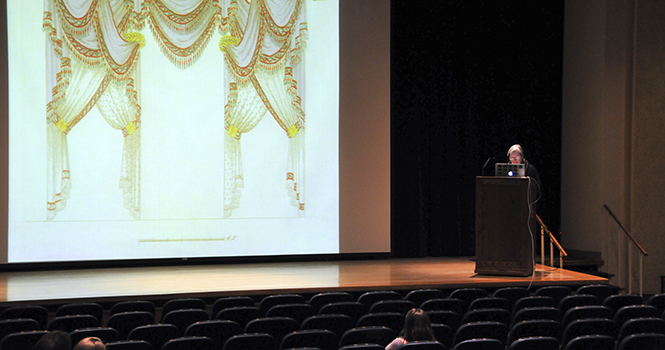Historian speaks about interior design through the ages
Gail Caskey Winkler, Director of the Graduate Program in Historic Preservation at the University of Pennsylvania, speaks to students and faculty in the KIVA on Monday, February 25, 2013. Dr. Winkler discussed historical interior design that spanned from the Industrial revolution in 19th century Great Britain for textiles to the development of interior design books in France to American interior design and her restoration efforts around the country. Photo by JESSICA DENTON.
February 26, 2013
Design historian and professor Gail Caskey Winkler spoke about interior design through the ages at the Kiva Monday evening.
Winkler teaches historic preservation in the graduate program at the University of Pennsylvania and a two-semester course called the “History of the American Interior.”
She discussed her book, “Capricious Fancy: Draping and Curtaining the Historic Interior, 1800-1930,” which captures the essence of her expertise in upholstery throughout the 19th century.
“There are 350 illustrations taken from over 100 19th and 20th century publications arranged in chronological order,” Winkler said.
She explained illustrations from that time typically contained scales at the bottom of the page, so that craftsmen could copy the work. They were intended only for fellow craftsmen, so they had no textual instructions.
In the mid 19th century, Winkler said, drapery and curtains were beginning to be used on anything from fireplaces to pianos and mirrors.
Winkler went on to explain the different historic roles of the English and French in the interiors of homes.
“It was cool how the style was from different places,” said Evan Mason, freshman architecture major who attended the speech.
While the English originated the industrial production of textiles, the French created interior decoration, Winkler said.
The elegant French draperies took taste and skill to put them up, Winkler said, and were much different than the English designs.
The first English book was published in 1819. The French kept their drapery patterns a secret to themselves for much longer.
“The very first French book to focus solely on drapery cutting patterns… was published in 1851, fully 50 years after the French began to produce those beautiful drawings,” Winkler said.
In the 1800s, dead animals became a fad used solely in the dining room, Winkler said. They were carved into furniture, used as curtain drawbacks and on window shades.
“She interested me; she was a good speaker,” said Kaitlyn Kough, sophomore interior design major. “The dead animal decorations in the dining room were really bizarre.”
At the end of the 19th century and into the early 20th century, there was a backlash of the upholstery overuse, Winkler said. This time period, called “The Clean-up,” used simpler designs and less fabric, which can still be seen in today’s designs.
“I have only shared with you a few of the 350 illustrations in ‘Capricious Fancy,’” Winkler said in closing. “I hope it gives you some indication as to the changing professions of the 130 year period that the book covers.”
Contact Anna Lemmon at [email protected].
























